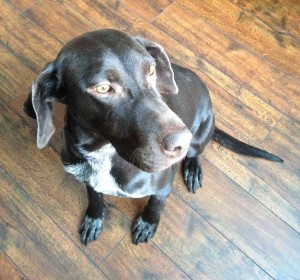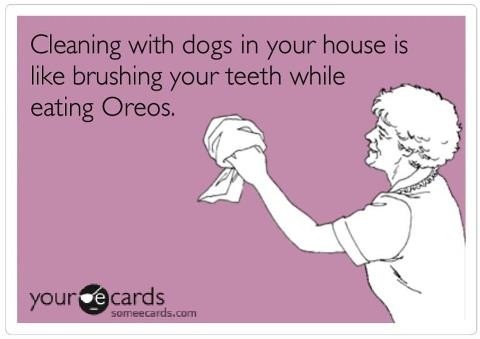Thanks to our guest blogger, Emma Olson, for sharing her experience with shedding in her dog Brownie.

Dog Hair
About a month ago, I started noticing how often I was sweeping my floors. It wasn’t dirt I was piling into my dustpan, but dog hair. So. Much. Dog. Hair.
This can’t be normal, I thought as I watched Brownie, my 7-year-old pointer/lab mix, walk across my clean floors. I could literally see the stray hair follicles fly off her shoulders as she moved. It was time to Google this.
Shedding is a natural process, of course, but a variety of factors can impact the frequency and amount of hair lost:
Emma’s dog, Brownie, has quite the shedding problem.
Breed
Each breed has a different hair and skin type. A German shepherd may shed year-round, while a poodle doesn’t lose much hair at all. Some have a prickly coat, others curly hair, while some are long and shaggy; getting to know your dog’s breed will help you learn the best methods for managing his or her fur.
Environmental Factors
The changing seasons play a big part in your dog’s shedding. The whole process is a way for a dog to stay cool in the summer and warm in the winter, losing hair and growing more hair to make up for the climate shift. Shedding follows sunlight patterns so because most of our furry friends live inside under artificial light, their shedding cycle isn’t controlled. This is why indoor dogs are also more likely to shed throughout the year. For most, brushing and bathing your dog regularly can help curb excessive shedding.
Dietary Deficiencies
An all-kibble diet may not be providing your dog with the nutrients he or she needs, especially if it’s a lower-quality brand. Fillers like corn and grain can be difficult for your dog to digest, so look for meat-rich food to add the nutrients he or she needs. It may cost a little more, but its overall better for your furry friend.
If more expensive dog food isn’t in your budget, adding some of the leftovers from your plate can also be effective. Eggs, broccoli and chicken make great treats that add protein and vitamins to kibble. Or look for omega-3 in your dog food ingredients. This fatty acid can enhance the texture and shine of fur, and help decrease dandruff.
Keep in mind: although most of the foods you eat are safe for your pet, there are some things you should never give your dog. Check out another great dogIDs blog post for specific details on what not to share with Rover.
If your pup is prone to allergies, you may need to experiment with different types of food. Definitely consult your vet for advice. They may even have safe supplements at their office for you to purchase.
Health Concerns
The overall emotional health of your dog can also be a trigger for additional shedding. If your pup is high-stressed or there’s been a change in their environment (moving, death in the family, etc.), a little extra love and supplements (ask your vet) can get him back into a normal groove.
Hormonal imbalances also lead to shedding. Your vet can help you determine if your dog is producing too little or too much of something. Typically, medication can help to stabilize hormones.
Skin conditions including parasites, dermatitis and infections can cause hair loss. Call your veterinarian if hair loss is spotty or patchy, or the skin is bumpy, red or tender. This can be a sign of something more worrisome. Watch also for excessive licking and/or scratching.

Photo Found on Pinterest
In any case, we recommend you check with your veterinarian. He or she can tell you if your dog’s shedding is natural or something more, and will be able to provide the best and safest solution for curbing hair loss. Regular trips to the vet and some at-home lifestyle changes can make all the difference.
In my dog’s case, we determined that diet was the issue. Her whole life, Brownie has eaten dry food. Her hair was always coarse and her skin was dry, but I really thought it had more to do with her breed and love of the outdoors, than anything to do with her health.
I started adding oil or egg to her meals, and sometimes even a tasty, meaty treat if we had leftovers from supper. In a week, I saw a difference in her coat. Now, it is soft and shiny, a complete change from before. I’ve also become more conscious of what’s in her manufactured food. Just like I do with my own food purchases, I’m checking the labels to make sure I understand the ingredients.
Remember, shedding is just a natural part of your dog’s life. These tricks likely won’t stop the shedding, but may help to reduce it. Brownie hair is still an accessory to my every outfit, but hey, that’s the joy of being a pet parent!
Are you about to pull your hair out (pun intended) because of out-of-control shedding? Share your experiences with us in the comments below.

